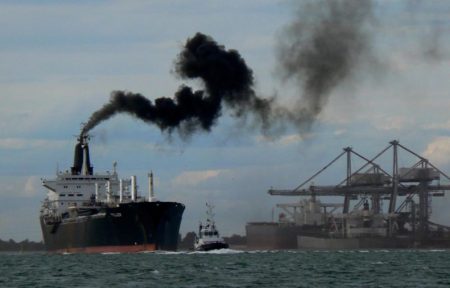September 14, 2018 – Bunker oil is the dirtiest liquid fossil fuel energy source on the planet. Today the vast majority of maritime shipping runs on the stuff which when burned emits many different types of greenhouse gases. Back in 2016 the International Maritime Organization (IMO) announced, that by January 2020, all marine fuels would decrease sulfur content by a factor of five, from 0.5% to 0.1% by weight. The ships affected represent 75% of the world’s maritime fleet.
Why is the IMO taking this first step? Because fuels containing sulfur are known producers of greenhouse gas emissions. The decision marks an interim step in the effort of the marine transport sector to address its contribution to climate change. Ship owners are already being asked to install smokestack scrubbers to reduce particulate matter, an aerosol known as black carbon, a known short-lived climate pollutant.
So what are the greenhouse gas emission numbers for maritime transport?
- 1 billion tons of CO2 representing approximately 3% of all global emissions and a number greater than the total emissions produced annually by Germany.
- 52% of these emissions come from three ship classes (23% from container ships, 19% from bulk carriers, and 13% from oil tankers.
- 21% of the black carbon released annually into the atmosphere comes from marine traffic.
Until recently the IMO dragged its feet in regulating greenhouse gas emissions from its members. The reduction measures being applied encouraged shippers to build bigger boats because the CO2 and equivalent emissions were applied to transport units of work. This is the same logic used by regulators of Alberta’s oil sands that applied emission constraints based on CO2 per barrel content, rather than the total amount of oil being produced. The results for maritime shipping have been the same as those in the oil sands. Overall emissions have continued to climb.
The IMO has a roadmap to reduce emissions in what it describes as recognizing its “fair share” of contributions to global targets. Meanwhile, bigger ships and more bunker fuel is contributing to global carbon emissions.
The sulfur limit states members of the IMO represents a demonstration of its commitment to meet environmental obligations. The next step, the organization states, is to address CO2 with 2050 the target date for a 50% emission reduction. And beyond that, the IMO is committed to a 100% reduction in greenhouse gas emissions by 2100.
With more than 50,000 ships traveling the world’s oceans, the sulfur limit in bunker fuels starting in 2020 should have a meaningful impact. But for the maritime shipping industry to achieve the CO2 target means a wholesale change in propulsion technology looking at converting ships to burn liquid natural gas (LNG), hydrogen, and to draw supplemental power from solar, wind, and batteries.
When asked about the impact this will have on maritime shippers, Frank Starke, Global Product Manager Medium Speed Engines, at Caterpillar, states “The required massive investments of creative intelligence and capital can only be justified if there is a predictable, globally harmonized emission regulation regime. Adherence to these regulations must be monitored effectively and enforced strictly to create a level playing field around the world.”
So the question remains, is the IMO prepared to rigorously enforce multi-decadal changes to the technology being used by its members in an effort to combat greenhouse gas emissions? Will it produce target milestone dates as guidance for its members to reach interim reduction levels beginning today and until that 2050 target date and beyond?
In a recent survey, UBS, the Swiss bank, stated that the maritime industry between 2019 and 2023 needs to spend more than $250 billion US on equipment to comply with current green shipping requirements. Meeting the 2050 goal will represent multiples of that $250 billion. Will the industry commit to it? Starke and others in the IMO leadership say “we must.”
















